
What is Jirisan?
Jirisan is the first government-designated national park in the Republic of Korea.
It is a mountainous national park that has the largest area with over 20 peaks.
Jirisan is the home of a wide spectrum of living things thanks to the unique natural environment that made it an ecological zone with the highest humidity on the Korean peninsula.
* National Park designation
- Included in an International Union for Conservation of Nature (IUCN) category (2007)
- Added to the IUCN's Green List (2014)
What's in Jirisan
Many types of living things thrive in Jirisan as it features diverse natural conditions in terms of temperature and precipitation on unique topography with an elevation difference of between 110 m and 1,915 m above sea level.
The soil of Jirisan is a treasure trove that harbors a 2.3-billion-years-old mystery of life.
Jirisan is a paradise of plants inhabited by about 30% of all plant varieties found on the Korean peninsula. Naturally, the people of Namwon, a city adjacent to Jirisan, have cultivated and used plants grown in Jirisan for centuries.
Chrysanthemum(Chrysanthemum indicum L.)

Chrysanthemum flowers that grow in mountains and fields throughout the country are called wild chrysanthemums. They have a sweet taste when you chew on them. They are mainly taken as tea and the flowers are also used as a medicine as they are known to make you feel light, slow the aging process, and increase longevity.
Chrysanthemum from Jirisan, Namwon
Namwon chrysanthemums are covered by short hairs and have reddish stems that grow as creepers. The leaves are mostly dark green in color and those on the lower parts of the stem have a shape of chrysanthemum leaves, but as you move up the stem, the leaves become smaller and thinner. The yellow petals of the Namwon chrysanthemum flowers are packed together densely without overlapping. The flowers are picked when the yellow color becomes most vivid before the frost falls.
Ingredient efficacy

Ingredient info
Manufacturer: The Garden of Naturalsolution Inc.
Product name: Namwon Chrysanthemum Extract
INCI: Chrysanthemum Indicum Extract
Inquiries: www.naturalsolution.co.kr
Multiflora roses (Rosa multiflora Thunb.)
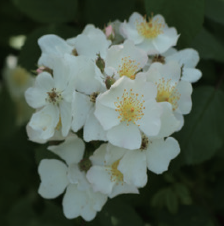
As the name indicates, multiflora roses are abundant with flowers. The scientific name of multiflora roses is also Rosa multiflora Thunb., with rosa meaning rose in Latin, and multiflora meaning that the plant has many flowers. In the old days, people used to collect the dew that fell on the multiflora roses in the morning of Dano(a Korean traditional festival celebrating the fifth day of the fifth month of the lunar calendar) and apply them on their face or wash their faces by rubbing them with the petals.
Multiflora roses from Jirisan, Namwon
Namwon multiflora roses that usually grow at the foot of the mountains bloom in mid-May, about a week after the multiflora roses that grow on flatlands bloom. Multiflora roses love the sun and each heart-shaped petal faces the sky as if they roll up the edges of the petals. Namwon multiflora roses are picked on a sunny day in May when the flowers are in full bloom.
Multiflora roses, wild flowers in full vigor
Every year, multiflora roses bloom only on newly grown branches. The fruit that grows after the flowers fall contains six to twelve seeds. A single multiflora rose tree can generate approximately 500,000 seeds annually. Multiflora rose seeds that are buried in the soil have great longevity and can stay alive for 10 to 20 years.
Ingredient efficacy
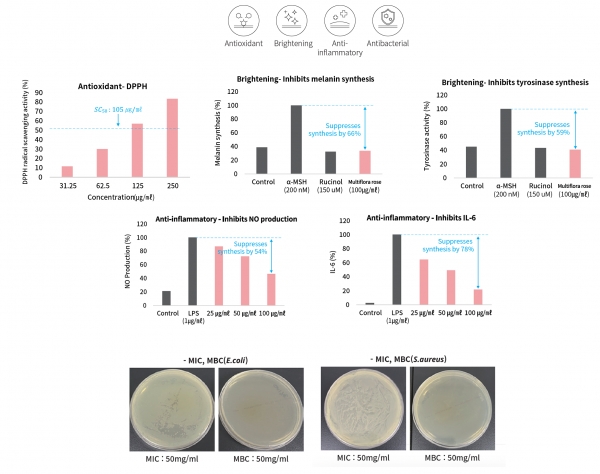
Ingredient info
Manufacturer: Luvama Biolab Inc.
Product name: Organic Multiflora Rose Flower Extract
INCI: Rosa Multiflora Flower Extract
Inquiries: www.luvama.co.kr
Thistles (Cirsium japonicum Fisch. ex DC. var. maackii (Maxim.) Matsum.)
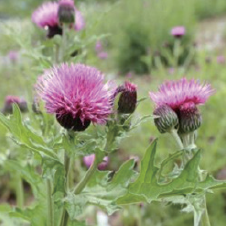
The scientific name for thistles is Cirsium japonicum. The genus name Cirsium comes from a Greek word (Kirsion or Cirsion), which means swollen vein, and the Korean name, Ung-gung-kwi, also means an herb that clots blood. In the West, they call plants that have forked leaves with thorns along the edges and produce pink or pinkish purple colors “thistles” in general. Milk thistle, famous for its quality that improves liver health, is a Silybum marianum of the genus Silybum, which originated in Europe and the Mediterranean.
Thistles from Jirisan, Namwon
Namwon thistles grow primarily on mountain slopes in groups and are in full bloom between early June and early August. Every year when the summer begins in Namwon, people are busy picking thistle flowers that have bloomed early in the morning.
Thistles hiding pollen inside
Thistle flowers are composed of hundreds of whole flowers that look like pinkish purple tubes in the center. The pink tubes have pollen inside but you can’t see them in flowers that have just bloomed. However, when bees and butterflies sit on the flower to drink the nectar at the bottom of the tube, the pink tubes tear open and the pollen spills out to sprinkle on the insects. Throughout summer, thistles act as a source of honey, sharing nectar and pollen.
Ingredient efficacy
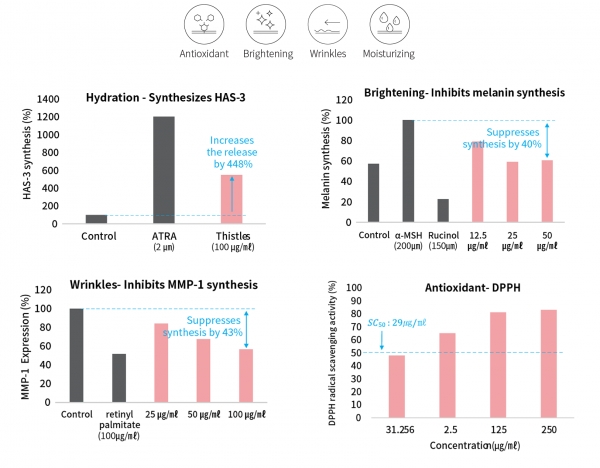
Ingredient info
Manufacturer : BioSpectrum Inc.
Product name : Darkui · Cirex
INCI : Cirsium flower/leaf/stem extract
Inquiries : www.ebiospectrum.kr
Artemisia (Artemisia umbrosa Turcz. ex DC.)

Artemisia is found in many parts of the world not only in Korea, but also throughout Southeast Asia, Europe, and the Americas. It is known to have about 400 different varieties. The genus name Artemisia is derived from the name Artemis, the goddess of wildlife and childbirth in Greek mythology, because it is considered to be effective on female reproductive system diseases. Artemisia from Europe, among other regions, often has too many medicinal properties and, therefore, cannot be used in daily life, but those grown in Korea can be used widely as both food and medicine.
Artemisia from Jirisan, Namwon
In the early spring, artemisia sprouts grow in large numbers in suntraps. Among the plants there, artemisia leaves are covered in fluffy white hair and have white dots, making it easy to distinguish it from regular artemisia. In July, when the mountains and fields all turn green, farmers harvest the artemisia that have grown to match the height of an adult and are brimming with the fragrance of nature in midsummer.
Artemisia that has kept us healthy for ages
Artemisia is a familiar plant to Korean people. It even appears in the origin myth of the country. It is a traditional ingredient popular in Spring, which is used to make artemisia rice cakes and artemisia soup. There are over 30 artemisia varieties that grow naturally in Korea, all of which are used for different purposes depending on the variety. Artemisia that can be spotted on sunny land is not only widely used as a good ingredient, but also as a medicinal herb.
Ingredient efficacy
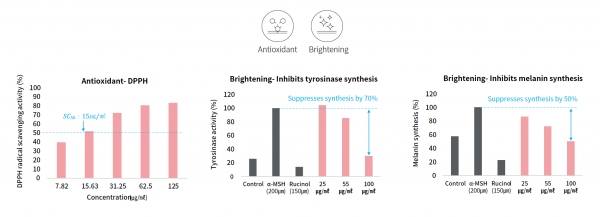
Ingredient info
Manufacturer : Product name: Artemisia Princeps Extract
INCI : Artemisia Umbrosa Extract
Inquiries : sooy-k.com

